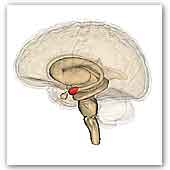|
Our brains are constantly active, processing a
myriad of visual stimuli. Faces are particularly
important social stimuli, and, indeed, the human
brain has networks of neurons dedicated to
processing faces.

New research from Caltech now shows that the
activation of face cells depends highly on where you
are paying attention—it is not enough for a face to
simply be within your field of vision. The findings
may lead to a better understanding of the mechanisms
behind social cognitive defects that characterize
conditions such as autism.
The research was conducted in the laboratories of
Ralph Adolphs (PhD '93), Bren Professor of
Psychology and Neuroscience and professor of
biology, and collaborator Ueli Rutishauser (PhD '08)
of Cedars-Sinai Medical Center in Los Angeles and a
visiting associate in biology and biological
engineering at Caltech.
The researchers focused on face cells in a
particular region of the brain called the amygdala.
"We know that a damaged amygdala can result in
profound deficits in face processing, especially in
recognizing emotions, but how amygdala neurons
normally contribute to face perception is still a
big open question," says Juri Minxha, a graduate
student in Caltech's computation and neural systems
program and lead author on the paper.
When a face cell responds to a stimulus, it fires
electrical impulses or "spikes." By working with
patients who already had electrodes implanted within
their amygdalae for clinical reasons, the group
measured the activity of individual face cells while
simultaneously monitoring where a subject looked.
Subjects were shown images of human faces, monkey
faces, and a variety of other objects such as
flowers and shapes. This study is the first in which
subjects were free to look around at various parts
of a screen and focus their attention on different
things.
The study found two types of face cells: those that
fire more spikes when the patient is looking at a
human face and those that fire a few spikes when the
patient is looking at a face of another species (in
this case, that of a monkey). Neither type of face
cell fired when the subjects were paying attention
to objects that were not faces, even if those
objects were near a face in the image.
The studies showed that when the monkey and human
subjects were viewing images of the same species,
the monkeys' face cells reacted about one-tenth of a
second more quickly than the face cells of humans,
validating a long-standing hypothesis that face
cells in monkeys would respond more quickly than
corresponding cells in humans. The tenth-of-a-second
difference is larger than what can be explained by
variation in human and monkey brain size, leaving
open the question of why human face cells have a
delayed response.
For more information
Cell Reports
Fixations Gate Species-Specific Responses to Free
Viewing of Faces in the Human and Macaque Amygdala
Juri Minxha, Clayton Mosher, Jeremiah K. Morrow,
Adam N. Mamelak, Ralph Adolphs, Katalin M. Gothard,
Ueli Rutishauser
Link...
Caltech - California Institute of Tecnology
Link...
MDN |